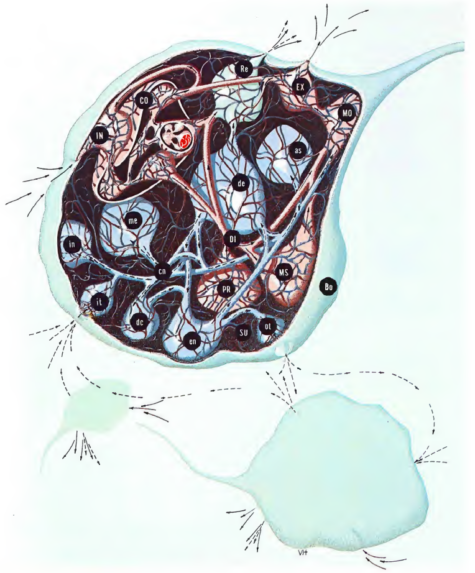Towards a general theory of living systems, we should be looking beyond the singletons of a hierarchical level, i.e. (i) cell, (ii) organ, (iii) organism, (iv) group, (v) organization, (vi) community, (vii) society, and (viii) supranational level.
In a scientific approach, James Grier Miller created a list of hypotheses. In the 1100+ page book, the hypotheses were not proved or disproved. However, reviewing some of the hypotheses presents interesting questions as to whether an espoused systems thinker is actually sweeping in knowledge across multiple types of systems, or just reducing scope to a single system or type of system.
In this chapter I focus attention on hypotheses which apply to two or more levels of systems, because of their powerful generality. These are more than propositions of systems theory: they are general systems theoretical hypotheses. Several of the assertions I have made in my fundamental statement of general living systems theory in the preceding two chapters are, of course, cross-level hypotheses or propositions of this sort. Such, for instance, is the assertion that all living systems which survive have all the critical subsystems, or are parasitic upon or symbiotic with systems which do (see page 32). [….]
Of the hypotheses stated below, some are probably true for all levels, some only for certain levels, some only if modified, and others are probably false. For some the question is: Is it true or false? For others the question is: Does it apply at a given level? [p. 90]
Miller does append a level of confidence to whether the hypothesis is true, or not.
A good many representative cross-level hypotheses are presented briefly below. Each is worth consideration for its own sake. My personal confidence that a given proposition could be shown to be true and relevant to two or more levels is indicated by a letter in parentheses after each hypotheses, as follows: (H) means it is high; (M) means medium; and (L) means low. [p. 92]
For a detailed explanation of each hypothesis, readers should consult the book directly. The items that are most basic, and then somewhat interesting, follow.
On structure (in section 1, that we can read as arrangement in space):
- Hypothesis 1-1: In general, the more components a system has, the more echelons it has. (M)
- Hypothesis 1-2: In general, the more structurally different types of members or components a system has, the more segregation of functions there is. (M) [p. 92]
Those hypotheses, above, could be applied in a differentiation between complex structures (with multiple echelons) and complicated structures (of many components).
On process (in section 2, that we can read as arrangement in time):
- Hypothesis 2-1: System components incapable of associating, or lacking experience which has formed such associations, must function according to rigid programming or highly standardized operating rules. It follows that as turnover of components rises above the rate at which the components can develop the associations necessary for operation, rigidity of programming increases. (H)
- Hypothesis 2-2: The more rapid reassignment of function from one component to another a long-surviving system has, the more likely are the components to be totipotential rather than partipotential. (M)
- Hypothesis 2-3: The more isolated a system is, the more totipotential it must be. (H)
- Hypothesis 2-4: A system’s processes are affected more by its suprasystem than by its suprasuprasystem or above, and by its subsystems than by its subsubsystems or below. (L) [p. 92]
These hypotheses could be useful in distinguishing between a living system that has processes, multiple living systems that might be misrepresented as aggregated, and non-living systems.
Turning to subsystems (in section 3), there no hypotheses about the reproducer. Either Miller thought that systems at different hierarchical levels reproduce in specific ways, or had not yet developed any testable hypotheses.
Relationships amongst subsystems or components (in section 4) has 3 hypothesis rated with low (L) confidence. I’ll skip those.
Systems processes are in section 5. I’ll skip over 5.1 (Process relationships between inputs and outputs) that are mostly about functioning within normal ranges.
Adjustment processes among subsystems or components, used in maintaining variables in steady states (in section 5.2) are more interesting.
- Hypothesis 5.2-1: As stress increases, it first improves system output performance above ordinary levels and then worsens it. What is extreme stress for one subsystem may be only moderate stress for the total system. (L)
- Hypothesis 5.2-2: The greater a threat or stress upon a system, the more components of it are involved in adjusting to it. When no further components with new adjustment processes are available, the system function collapses. (M)
- Hypothesis 5.2-3: When variables in a system return to a steady state after stress, the rate of return and the strength of the restorative forces are functions — with increasing first derivatives greater than 1 — of the amount of displacement from the range of stability. (M)
- Jypothesis 5.2-4: The range of stability of a system for a specific variable under lack strain is a monotonically increasing function of the amount of storage of the input,and under excess strain, it is a monotonically increasing function of the rate of output. (L)
- Hypothesis 5.2-5: There is an inertia to the matter-energy and information processing variables which a system maintains in steady state, so that change in their ranges of stability is much less disruptive of system controls if it is undertaken gradually. (L)
- Hypothesis 5.2-6: Positive feedback may produce continuous increments of outputs which give rise to “spiral effects” destroying one or more equilibria of a system. (H)
- Hypothesis 5.2-7: When a barrier stands between a system under strain and a goal which can relieve that strain, the system ordinarily uses the adjustment processes of removing the barrier, circumventing it, or otherwise mastering it. If these efforts fail, less adaptive adjustments may be tried, including: (a) attacking the barrier by energic or informational transmissions; (b) displacing aggression to another innocent but more vulnerable nearby system; (c) reverting to primitive, nonadaptive behavior; (d) adopting rigid, nonadaptive behavior; and (e) escaping from the situation. (L) [p. 105-106]
These hypotheses, above, are all about how living systems handle stress and strain.
I will skip over some hypothesis on how multiple components work together, and then “17 hypotheses [related] to the adjustment of conflicts” that speak more to goals and purposes.
Also “Growth, cohesiveness, and integration” in section 5-4, I will skip
Pathology (in section 5.5) has two items:
- Hypothesis 5.5-1: The farther away a component is from the point of trauma to a system , the less pathological is its function, and particularly the less is its relation to the system’s hierarchical organization destroyed. (L)
- Hypothesis 5.5-2: Abnormal or “neurotic” outputs can be elicited by rewarding one information input, not rewarding (or punishing) a similar information input, and then altering one or both until they are indistinguishable. (L) [p. 110]
These pathologies remind us that Miller’s research was in behavioral science, as the science of psychology was on the rise, separate from medicine.
Decay and termination, as section 5.6 (the last, before Miller transitions on suggesting how researchers might proceed), says that when a system ceases to exist, it becomes part of the suprasystem.
- Hypothesis 5.6-1: If a system’s negative feedback discontinues and is not restored by that system or by another on which it becomes parasitic or symbiotic, it decomposes into multiple components and its suprasystem assumes control of them. (H)
Having spent some time reading the writings of James Grier Miller, I might have missed a distinct distinction between a living system and a non-living system. However, termination would suggest a living system that is no longer alive.
References
Miller, James Grier. 1978. “Hypotheses Concerning Living Systems.” In Living Systems, 89–119. McGraw-Hill.



